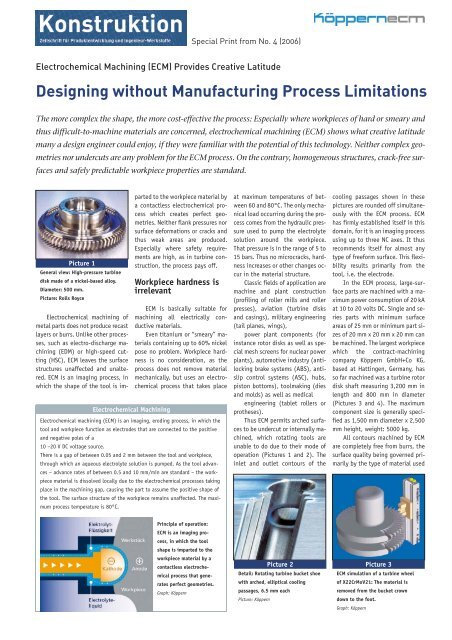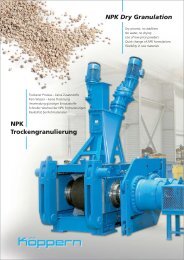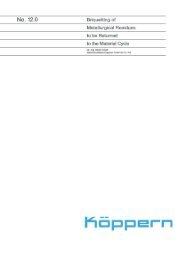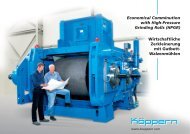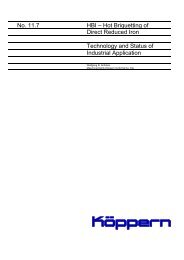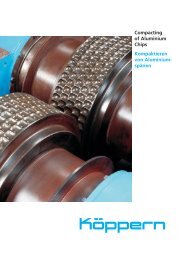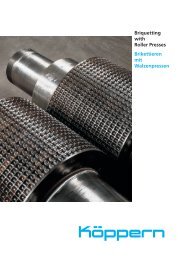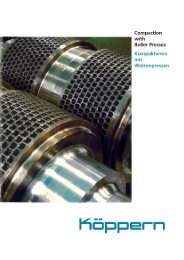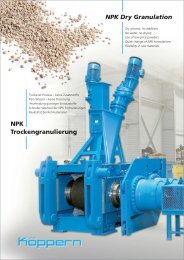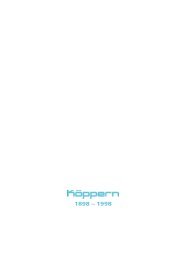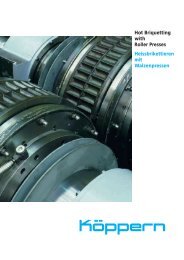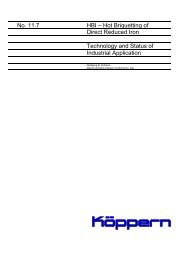Sonderdruck Köppern - Maschinenfabrik Köppern GmbH & Co. KG
Sonderdruck Köppern - Maschinenfabrik Köppern GmbH & Co. KG
Sonderdruck Köppern - Maschinenfabrik Köppern GmbH & Co. KG
You also want an ePaper? Increase the reach of your titles
YUMPU automatically turns print PDFs into web optimized ePapers that Google loves.
Electrochemical Machining (ECM) Provides Creative Latitude<br />
Designing without Manufacturing Process Limitations<br />
The more complex the shape, the more cost-effective the process: Especially where workpieces of hard or smeary and<br />
thus difficult-to-machine materials are concerned, electrochemical machining (ECM) shows what creative latitude<br />
many a design engineer could enjoy, if they were familiar with the potential of this technology. Neither complex geometries<br />
nor undercuts are any problem for the ECM process. On the contrary, homogeneous structures, crack-free surfaces<br />
and safely predictable workpiece properties are standard.<br />
Picture 1<br />
General view: High-pressure turbine<br />
disk made of a nickel-based alloy.<br />
Diameter: 500 mm.<br />
Picture: Rolls Royce<br />
Electrochemical machining of<br />
metal parts does not produce recast<br />
layers or burrs. Unlike other processes,<br />
such as electro-discharge machining<br />
(EDM) or high-speed cutting<br />
(HSC), ECM leaves the surface<br />
structures unaffected and unaltered.<br />
ECM is an imaging process, in<br />
which the shape of the tool is im-<br />
parted to the workpiece material by<br />
a contactless electrochemical process<br />
which creates perfect geometries.<br />
Neither flank pressures nor<br />
surface deformations or cracks and<br />
thus weak areas are produced.<br />
Especially where safety requirements<br />
are high, as in turbine construction,<br />
the process pays off.<br />
Workpiece hardness is<br />
irrelevant<br />
ECM is basically suitable for<br />
machining all electrically conductive<br />
materials.<br />
Even titanium or “smeary” materials<br />
containing up to 60% nickel<br />
pose no problem. Workpiece hardness<br />
is no consideration, as the<br />
process does not remove material<br />
mechanically, but uses an electrochemical<br />
process that takes place<br />
Electrochemical Machining<br />
Electrochemical machining (ECM) is an imaging, eroding process, in which the<br />
tool and workpiece function as electrodes that are connected to the positive<br />
and negative poles of a<br />
10 –20 V DC voltage source.<br />
There is a gap of between 0.05 and 2 mm between the tool and workpiece,<br />
through which an aqueous electrolyte solution is pumped. As the tool advances<br />
– advance rates of between 0.5 and 10 mm/min are standard – the workpiece<br />
material is dissolved locally due to the electrochemical processes taking<br />
place in the machining gap, causing the part to assume the positive shape of<br />
the tool. The surface structure of the workpiece remains unaffected. The maximum<br />
process temperature is 80°C.<br />
Principle of operation:<br />
ECM is an imaging process,<br />
in which the tool<br />
shape is imparted to the<br />
workpiece material by a<br />
contactless electrochemical<br />
process that generates<br />
perfect geometries.<br />
Graph: <strong>Köppern</strong><br />
Special Print from No. 4 (2006)<br />
at maximum temperatures of between<br />
60 and 80°C. The only mechanical<br />
load occurring during the process<br />
comes from the hydraulic pressure<br />
used to pump the electrolyte<br />
solution around the workpiece.<br />
That pressure is in the range of 5 to<br />
15 bars. Thus no microcracks, hardness<br />
increases or other changes occur<br />
in the material structure.<br />
Classic fields of application are<br />
machine and plant construction<br />
(profiling of roller mills and roller<br />
presses), aviation (turbine disks<br />
and casings), military engineering<br />
(tail planes, wings),<br />
power plant components (for<br />
instance rotor disks as well as special<br />
mesh screens for nuclear power<br />
plants), automotive industry (antilocking<br />
brake systems (ABS), antislip<br />
control systems (ASC), hubs,<br />
piston bottoms), toolmaking (dies<br />
and molds) as well as medical<br />
engineering (tablet rollers or<br />
protheses).<br />
Thus ECM permits arched surfaces<br />
to be undercut or internally machined,<br />
which rotating tools are<br />
unable to do due to their mode of<br />
operation (Pictures 1 and 2). The<br />
inlet and outlet contours of the<br />
Picture 2<br />
Detail: Rotating turbine bucket shoe<br />
with arched, elliptical cooling<br />
passages, 6.5 mm each<br />
Picture: <strong>Köppern</strong><br />
cooling passages shown in these<br />
pictures are rounded off simultaneously<br />
with the ECM process. ECM<br />
has firmly established itself in this<br />
domain, for it is an imaging process<br />
using up to three NC axes. It thus<br />
recommends itself for almost any<br />
type of freeform surface. This flexibility<br />
results primarily from the<br />
tool, i.e. the electrode.<br />
In the ECM process, large-surface<br />
parts are machined with a maximum<br />
power consumption of 20 kA<br />
at 10 to 20 volts DC. Single and series<br />
parts with minimum surface<br />
areas of 25 mm or minimum part sizes<br />
of 20 mm x 20 mm x 20 mm can<br />
be machined. The largest workpiece<br />
which the contract-machining<br />
company <strong>Köppern</strong> <strong>GmbH</strong>+<strong>Co</strong> <strong>KG</strong>,<br />
based at Hattingen, Germany, has<br />
so far machined was a turbine rotor<br />
disk shaft measuring 3,200 mm in<br />
length and 800 mm in diameter<br />
(Pictures 3 and 4). The maximum<br />
component size is generally specified<br />
as 1,500 mm diameter x 2,500<br />
mm height, weight: 5000 kg.<br />
All contours machined by ECM<br />
are completely free from burrs, the<br />
surface quality being governed primarily<br />
by the type of material used<br />
Picture 3<br />
ECM simulation of a turbine wheel<br />
of X22CrMoV21: The material is<br />
removed from the bucket crown<br />
down to the foot.<br />
Graph: <strong>Köppern</strong>
and the machining direction. If hard metal is<br />
machined, for example, the carbides contained<br />
in the metal are not electrically conductive,<br />
while the metallic matrix in which<br />
they are embedded is. As a result, the machined<br />
hard metal surface is coarser than what<br />
would be obtained with continuously electrically<br />
conductive workpiece materials and<br />
uniform erosion.<br />
On the other hand, the front gap – which<br />
is the distance between the electrode and<br />
the workpiece in machining direction – is<br />
between 0.02 and 0.1 mm, which is very<br />
small and makes for extremely accurate machining.<br />
The surface quality is correspondingly<br />
high. However, in the side gap, which<br />
may be up to 2 mm wide, there may be some<br />
waviness caused by the flow conditions. The<br />
average surface roughness is specified as R a<br />
= 0.5 μm or R z = 3 to 4. The achievable surface<br />
quality is thus somewhere between the<br />
quality levels obtained by finish milling and<br />
fine finishing. In the area of the front gap,<br />
even R a = 0.1 μm may be achieved.<br />
Regardless of the workpiece material,<br />
the average dimensional accuracy is 0.1 mm.<br />
However, exact tolerances can be specified<br />
only if the specific component to be manufactured<br />
is known. Here, the decisive factor<br />
is the overall relationship between the material<br />
and the dimensional specifications,<br />
between the number and location of the ECM<br />
contours and between the machining strategy<br />
and the tool specifications.<br />
Unrivaled advance and erosion<br />
rates<br />
ECM is suitable to machine all workpiece<br />
materials that are electrically conductive.<br />
The material is removed without any contact<br />
between the workpiece and the tool. As a result,<br />
the geometric reproducibility is close<br />
to 100%. The hardness of the workpiece material<br />
is of secondary importance. At machining<br />
temperatures of 80°C maximum, the<br />
process does not thermally stress the material<br />
nor does it increase the material hardness<br />
or produce recast layers – molten material<br />
that leaves layers of very small fragments<br />
and suspended material on the surface.<br />
Thus the process avoids the formation<br />
of cracks in workpiece pockets and recesses.<br />
At 0.8 to 10 mm/min., the machining<br />
advance speed is unrivaled and results in<br />
material erosion rates that are 30% to 50%<br />
faster than what can be achieved by electrodischarge<br />
machining (EDM), for example.<br />
The machining quality is entirely independent<br />
of the operating personnel. The tool<br />
service life is theoretically unlimited, as the<br />
electrode operates without contact with the<br />
workpiece. It will consequently not wear out<br />
Picture 4<br />
In the ECM process, even sharpening<br />
the crown front is done in the same<br />
workpiece clamp.<br />
Picture: <strong>Köppern</strong><br />
even after thousands of machining operations<br />
and many years of use.<br />
The process offers economic advantages<br />
for small series production and in general for<br />
all applications where high-speed cutting<br />
(HSC) would be too expensive or technically<br />
infeasible due to complex geometries.<br />
Process reliability is better than that of<br />
other processes, which is of benefit in particular<br />
where expensive components are manufactured.<br />
Thus ECM guarantees optimum<br />
results in the machining of turbine disk rotor<br />
shafts by making sure, among other things,<br />
that the CNC control system stops the machining<br />
operation without causing damage<br />
to the workpiece when even the slightest<br />
technical problem occurs – for instance an<br />
unscheduled increase in the working current<br />
and the subsequent short circuit danger.<br />
A Special <strong>Co</strong>mmittee formed within the<br />
Verein Deutscher Ingenieure (VDI) is devoted<br />
to updating and revising Directive VDI<br />
3401, which has been in force since 1993.<br />
The Authors<br />
Dipl. Ing./Dipl.-Wirt.-Ing.<br />
Jörg Heuer<br />
Head of ECM Division<br />
<strong>Maschinenfabrik</strong> <strong>Köppern</strong><br />
<strong>GmbH</strong>+<strong>Co</strong>.<strong>KG</strong><br />
Königsteiner Straße 2<br />
D-45529 Hattingen<br />
Tel. 02324/207–264<br />
j.heuer@koeppern.de<br />
www.koeppern.de<br />
Dipl.-Ing. Wolfgang Fili<br />
Journalist based at <strong>Co</strong>logne<br />
fachjournalist@fili.net<br />
© Springer-VDI-Verlag <strong>GmbH</strong> & <strong>Co</strong>. <strong>KG</strong>, Düsseldorf 2006<br />
CAN THIS BE DONE?<br />
Machining complex<br />
geometries at extremely<br />
high speeds?<br />
Accurate reproducibility is<br />
particularly important where<br />
complex geometries are concerned.<br />
The solution is ECM – electrochemical<br />
machining of metal parts.<br />
Our ECM service offers you<br />
new perspectives in metal<br />
machining. ECM is a viable<br />
alternative to lathing,<br />
milling, eroding.<br />
We generate workpiece contours<br />
by electrochemical erosion, thus<br />
creating absolutely accurate,<br />
highly reproducible surfaces –<br />
at very high speed.<br />
All can be done with ECM!<br />
° Freeform surfaces<br />
° Absolutely free from burrs<br />
° Extremely hard materials<br />
° Short machining time<br />
° Surface quality R z< 3 μm<br />
° No structural transformation<br />
MASCHINENFABRIK<br />
KÖPPERN GMBH & CO <strong>KG</strong><br />
Königsteiner Straße 2<br />
45529 Hattingen<br />
Tel. (+49) 2324–207–0<br />
Fax (+49) 2324–207–205<br />
ecm@koeppern.de<br />
www.koeppern.de


